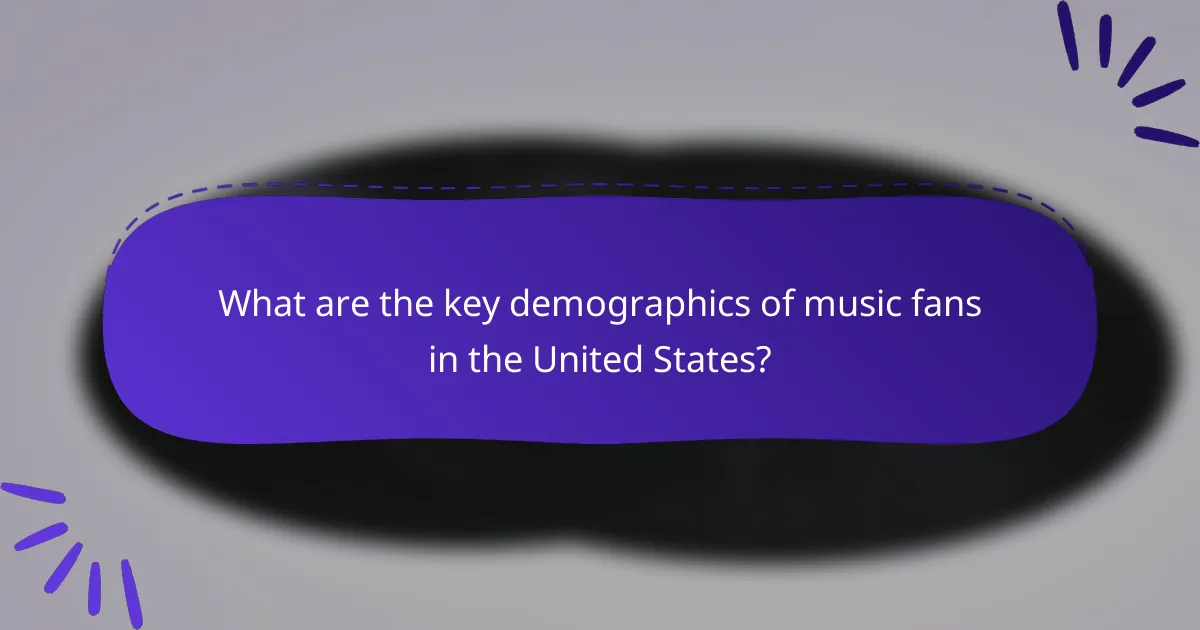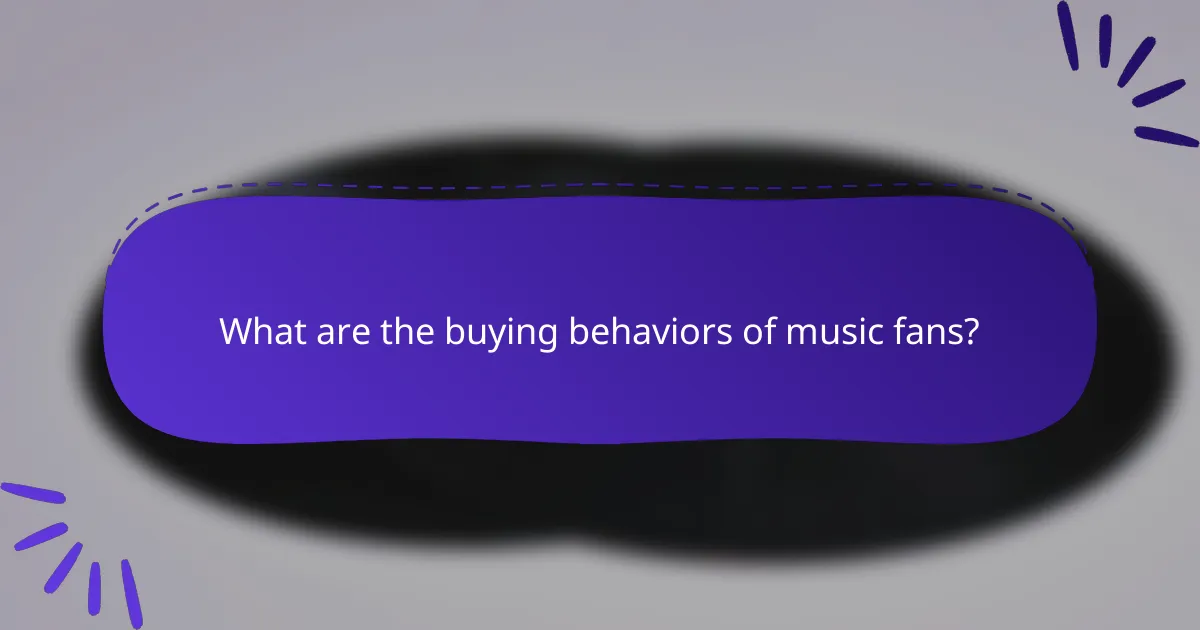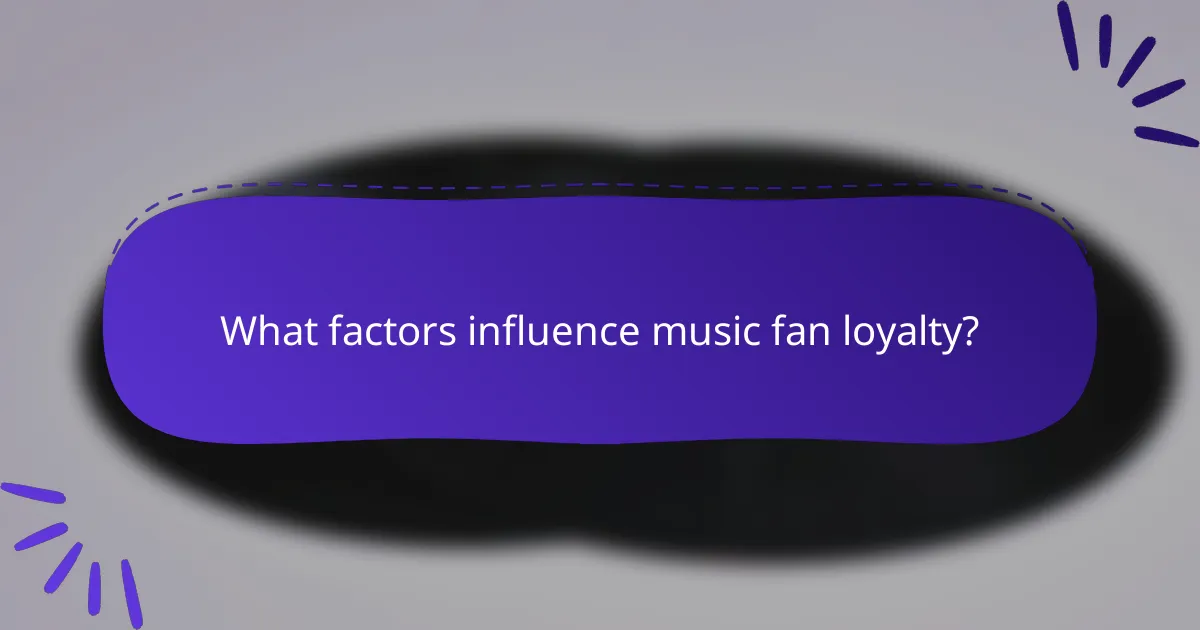The demographics of music fans in the United States showcase a rich tapestry of preferences and behaviors that vary by age, gender, and region. By analyzing these insights, artists and industry professionals can better tailor their approaches to connect with distinct audience segments, enhancing engagement and satisfaction. Understanding the influences of cultural trends and technological advancements on music preferences is crucial for navigating the evolving landscape of fan behavior.

What are the key demographics of music fans in the United States?
The demographics of music fans in the United States reveal diverse preferences and behaviors across various age groups, genders, and regions. Understanding these demographics can help artists, marketers, and industry professionals tailor their strategies to engage effectively with different segments of the audience.
Age distribution of music fans
The age distribution of music fans in the U.S. spans a wide range, with significant representation in both younger and older demographics. Typically, younger listeners, particularly those aged 18-34, are the most active consumers of new music, often gravitating towards genres like pop, hip-hop, and electronic dance music.
In contrast, older age groups, such as those aged 35 and above, tend to prefer classic rock, country, and jazz. This variation in age preferences highlights the importance of targeting specific age groups with tailored marketing strategies.
Gender breakdown among listeners
The gender breakdown among music listeners shows a fairly even split, with slight variations depending on the genre. For instance, pop and country music often attract a larger female audience, while rock and hip-hop may see more male listeners.
Understanding these gender preferences can help marketers and artists create content that resonates with their target audience, ensuring that promotional efforts align with listener demographics.
Geographic distribution of music preferences
Geographic distribution plays a crucial role in shaping music preferences across the United States. Urban areas typically showcase a wider variety of genres, including hip-hop, electronic, and indie music, while rural regions may lean more towards country and folk.
Regional influences can also affect the popularity of specific artists and styles, making it essential for marketers to consider local tastes when planning tours or promotional campaigns.
Income levels of music consumers
Income levels significantly impact music consumption habits. Higher-income individuals often have more disposable income to spend on concerts, merchandise, and premium streaming services, leading to a greater engagement with live music experiences.
Conversely, lower-income fans may rely more on free streaming platforms and radio, which can influence their exposure to new music and artists. Understanding these income dynamics can guide pricing strategies for events and products.
Education levels of music fans
Education levels among music fans can correlate with genre preferences and consumption patterns. Generally, individuals with higher education levels may gravitate towards genres like classical, jazz, and indie, while those with lower education levels might prefer mainstream pop and country.
This correlation suggests that educational background can influence not only music taste but also the methods of music consumption, such as attendance at live events versus digital streaming.

How do music preferences vary by age group?
Music preferences significantly differ across age groups, influenced by cultural trends, technological advancements, and personal experiences. Younger listeners tend to gravitate towards contemporary genres, while older generations often favor classic styles that shaped their formative years.
Popular genres among millennials
Millennials, typically aged between 25 and 40, show a strong preference for genres like pop, hip-hop, and electronic dance music (EDM). These genres resonate with their lifestyle and social experiences, often being associated with major cultural events and festivals.
Streaming platforms have played a crucial role in shaping these preferences, allowing millennials to discover and share music easily. Collaborative playlists and social media also enhance their engagement with these genres, making them more accessible and relatable.
Preferred artists for Gen Z
Gen Z, generally aged 10 to 25, favors artists who are often seen as authentic and relatable, such as Billie Eilish, Lil Nas X, and Olivia Rodrigo. This generation values diversity and inclusivity in music, leading to a broad appreciation for various styles, including indie pop, rap, and alternative rock.
Social media platforms like TikTok have a significant impact on their music choices, often propelling songs to viral status. This trend encourages Gen Z to explore new artists and genres, reflecting their desire for connection and community through music.
Classic rock preferences in older demographics
Older demographics, typically over 40, often have a strong affinity for classic rock, blues, and folk music. Bands like The Rolling Stones, Led Zeppelin, and Fleetwood Mac remain iconic, representing a nostalgic connection to their youth and significant cultural moments.
This age group tends to appreciate the lyrical depth and musicianship of classic rock, often attending live concerts and festivals celebrating these genres. Their loyalty to these artists is often reinforced by memories associated with the music, making it a lasting part of their identity.

What are the buying behaviors of music fans?
Music fans exhibit diverse buying behaviors that reflect their preferences and engagement with artists. Key factors include concert attendance frequency, streaming service subscriptions, and the choice between physical music purchases and digital downloads.
Frequency of concert attendance
Concert attendance is a significant indicator of a music fan’s engagement. Many fans attend concerts several times a year, with a notable portion going to multiple shows per month, especially for favorite artists. This behavior often correlates with a willingness to spend on merchandise and exclusive experiences.
Fans who frequently attend concerts may prioritize live experiences over other music-related purchases. They often seek out events in their local area, which can influence ticket pricing and availability.
Streaming service subscriptions
Streaming services have transformed how music fans consume music, with many opting for subscriptions to platforms like Spotify, Apple Music, or Amazon Music. A significant percentage of music fans maintain at least one subscription, often enjoying curated playlists and exclusive content.
When choosing a streaming service, fans consider factors such as music library size, user interface, and additional features like offline listening. Some fans may also use multiple services to access different catalogs or exclusive releases.
Physical music purchases vs. digital downloads
The trend in music purchases has shifted towards digital downloads and streaming, but physical music formats like vinyl and CDs still hold appeal for certain demographics. Many fans appreciate the tactile experience and collectible nature of physical formats, often purchasing them at concerts or specialty stores.
Digital downloads remain popular for their convenience and immediate access, but the resurgence of vinyl has created a niche market. Fans often weigh the benefits of owning a physical copy against the ease of digital access, leading to varied purchasing habits.

How do music fans engage with artists on social media?
Music fans engage with artists on social media primarily through interactions such as likes, comments, shares, and direct messages. These platforms allow fans to connect with their favorite musicians, share content, and participate in discussions, fostering a sense of community and loyalty.
Platforms most used by fans
The most popular social media platforms for music fans include Instagram, Twitter, and TikTok. Instagram is favored for its visual content, allowing artists to share photos and videos, while Twitter is used for real-time updates and conversations. TikTok has emerged as a significant platform for music discovery, with fans creating and sharing short videos featuring their favorite tracks.
Facebook remains relevant, especially for event promotion and fan groups, while YouTube serves as a primary source for music videos and live performances. Each platform offers unique ways for fans to engage, so artists often tailor their content to fit the strengths of each medium.
Types of content fans interact with
Fans typically engage with a variety of content types, including music videos, behind-the-scenes footage, live streams, and personal updates from artists. Music videos are particularly popular, as they provide a visual representation of songs and enhance the listening experience.
Behind-the-scenes content, such as studio sessions or tour preparations, allows fans to feel more connected to the artist’s creative process. Live streams have gained traction, enabling real-time interaction and a sense of exclusivity, while personal updates help fans relate to artists on a more human level.

What factors influence music fan loyalty?
Music fan loyalty is primarily influenced by emotional connections, brand partnerships, and merchandise preferences. Fans tend to remain loyal to artists and brands that resonate with their values and provide unique experiences.
Brand partnerships with artists
Brand partnerships can significantly enhance music fan loyalty by creating authentic connections between fans and artists. Collaborations that align with the artist’s image and values often resonate more deeply, fostering a sense of community among fans.
For example, a well-known beverage company partnering with a popular artist for a limited-edition product can drive fan engagement. Fans who identify with both the brand and the artist may feel more inclined to support both, enhancing their loyalty.
Merchandise preferences
Merchandise preferences play a crucial role in shaping music fan loyalty. Fans often seek unique, high-quality items that reflect their connection to the artist, such as exclusive apparel, vinyl records, or signed memorabilia.
Offering a variety of merchandise options can cater to different fan segments. For instance, younger fans may prefer trendy clothing, while older fans might value collectible items. Providing limited edition releases can create urgency and enhance loyalty as fans strive to own unique pieces.

How do cultural trends affect music consumption?
Cultural trends significantly shape music consumption by influencing the genres that gain popularity and the platforms through which music is accessed. As societal interests evolve, so do the preferences of listeners, leading to shifts in how music is discovered and enjoyed.
Impact of TikTok on music discovery
TikTok has transformed music discovery by enabling short, engaging clips that often go viral, leading to increased exposure for songs and artists. Many tracks that gain traction on the platform can see a surge in streaming numbers, often resulting in chart success.
Artists and labels now strategically create content tailored for TikTok, understanding that catchy hooks and memorable moments can capture attention quickly. This trend has led to a new form of marketing where the potential for a song to become a hit can hinge on its performance in a 15- to 60-second video.
For musicians, leveraging TikTok means being aware of current trends and participating in challenges or creating relatable content. However, it’s crucial to avoid over-saturation; focusing on authenticity can resonate better with audiences and enhance long-term engagement.

